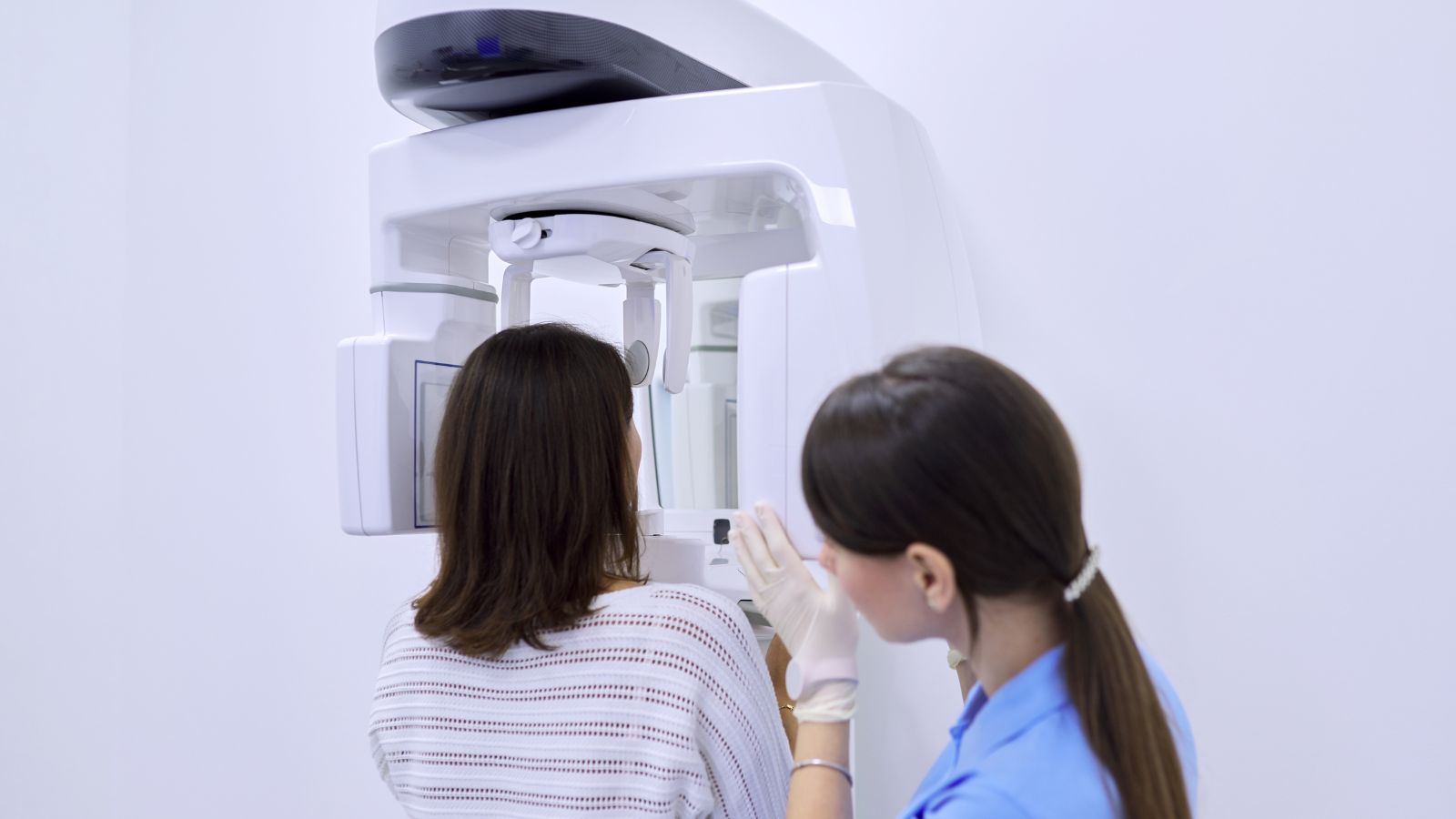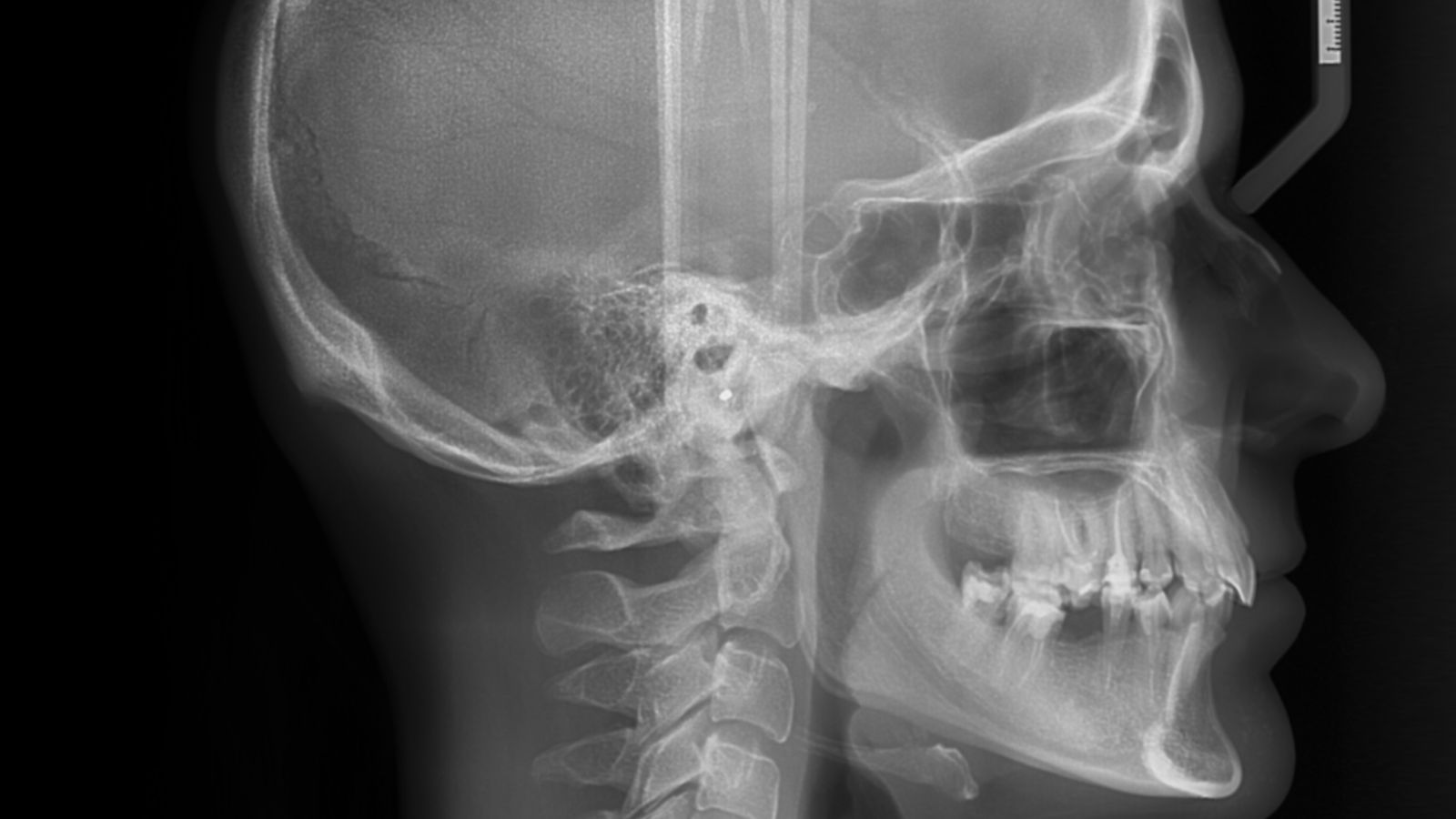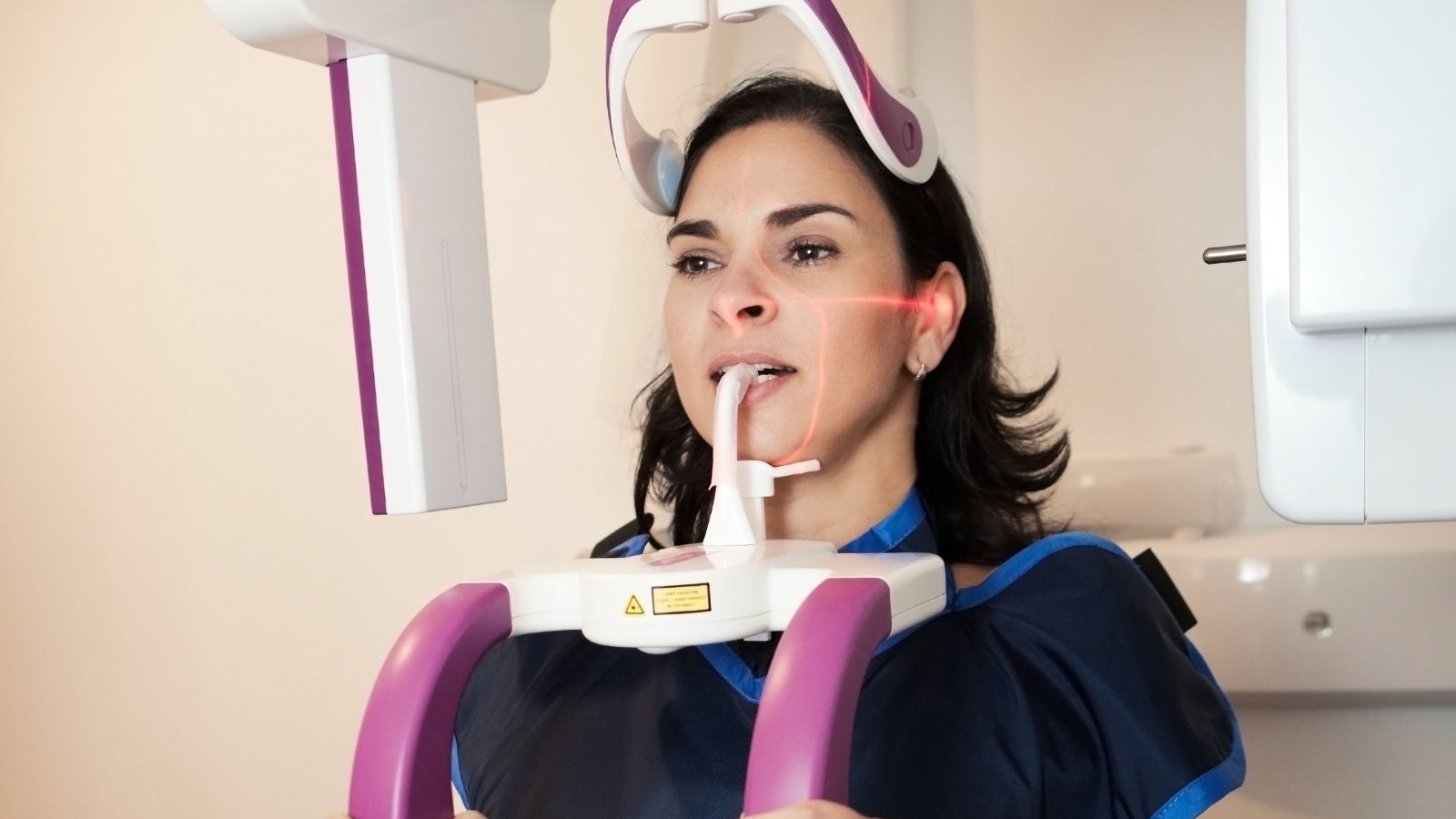3D Jaw and Tooth Tomography (technically known as Cone Beam Computed Tomography, or CBCT) is an advanced imaging method used to obtain three-dimensional, detailed images of the jawbone and teeth. This method allows for a clear examination of numerous details, from the bone structure of the jaw to the roots of the teeth, from joints to the sinuses. Therefore, it is a reliable technology that significantly simplifies diagnosis and treatment planning in dentistry and reduces the risk of complications.
What is 3D Jaw and Tooth Tomography?
3D Jaw and Tooth Tomography is a cross-sectional imaging method obtained with a specialized X-ray machine that allows for three-dimensional evaluation of teeth and jaw structures. It eliminates the two-dimensional limitations of traditional X-rays, providing dentists and patients with much more comprehensive information.
The basis of this technology is the rotation of a conical X-ray beam around the patient and the subsequent computer reconstruction of multiple 2D projections. The process produces the most realistic cross-sectional, three-dimensional images of teeth, bones, and other related structures. It provides precise and clear information, particularly in cases such as dental implant applications, jawbone evaluations, and impacted tooth analyses. Furthermore, its very short scanning time enhances patient comfort.
This method, unlike the bulky medical tomography scans used in general healthcare, focuses solely on the mouth and jaw area. This creates a three-dimensional dataset with lower radiation exposure, allowing for detailed examination. In short, 3D Jaw and Tooth Tomography is a technology developed specifically for dentistry, providing valuable information in the diagnosis and planning processes.
In Which Situations Is 3D Jaw and Tooth Tomography Preferred?
3D Jaw and Tooth Tomography is the imaging method of choice when more complex or critical details of the jaw and teeth are required. It is primarily used in the following types of cases: For example, it is highly useful for assessing bone volume and density for implant applications, determining the location of nerves in jaw surgery planning, determining the angle of impacted teeth in orthodontic treatments, detecting joint deformities, and analyzing advanced endodontic problems.
While 2D panoramic X-rays are often sufficient in dental practice, these two-dimensional data are insufficient in some cases. For example, extra root canals or narrow canals may be overlooked during root canal treatment. In such cases, 3D data significantly improves accuracy. Furthermore, 3D Jaw and Tooth Tomography offers the best solution when it is necessary to examine the bone structure of the jaw joint (TMJ).
What is the Difference Between 3D Jaw and Tooth Tomography and 2D X-Rays?
The biggest difference between 3D Jaw and Tooth Tomography and 2D X-Rays is the level of detail that the third dimension adds to the image. Two-dimensional panoramic or periapical X-rays provide an overlay of bone and tooth structures. Adjacent anatomical structures can sometimes obscure each other. In 3D tomography, cross-sectional images make it much easier to detect hidden lesions, tooth roots, or bone loss at any point.
Furthermore, 2D X-rays can experience size or angle errors. 3D Jaw and Teeth Tomography, on the other hand, allows measurements to be taken with a 1:1 ratio, providing a significant advantage in procedures where millimeter precision is crucial, such as implant placement and orthodontic movement planning.
Furthermore, the radiation dose is higher than 2D X-rays. However, thanks to technological advancements, many devices today offer options such as “low dose” or “pediatric mode,” significantly reducing the risk of unnecessary radiation. Nevertheless, unnecessary use should be avoided, and 3D tomography should only be considered if there is a real need for diagnosis and treatment planning.
How is 3D Jaw and Teeth Tomography Performed?
3D Jaw and Teeth Tomography is performed using a conical X-ray source and detector that rotates around the patient’s head. During the procedure, the patient remains in a fixed position, standing or sitting. The device takes hundreds of two-dimensional images with a single rotation; these images are combined using specialized computer software to create a single three-dimensional dataset. This dataset allows your physician to examine any cross-section and make accurate measurements.
Although the acquisition time can vary depending on the device and settings, it generally lasts between 5 and 40 seconds. The short scan time increases patient comfort and minimizes motion blur. The digital data obtained after the scan can be processed and analyzed immediately, allowing for rapid treatment planning.
Most devices today offer various field-of-view (FOV) options. For example, if a problem affects only a few teeth, a small area is selected and a low dose is applied. If the entire jaw or both jaws need to be examined, a larger dose is used.A wide area is scanned. This flexibility is crucial for reducing the risk of unnecessary radiation exposure by providing a personalized approach for each patient.
What Advantages Does 3D Jaw and Teeth Tomography Offer?
3D Jaw and Teeth Tomography offers many advantages in diagnosis and treatment planning by providing three-dimensional images. Firstly, it allows for the examination of anatomical structures without overlapping. This facilitates the detection of small details, such as cracks or additional canals in root canals. Furthermore, the precise determination of bone volume and nerve location in implant surgery significantly reduces surgical risks.
Another advantage is the ability to take much more accurate measurements. In implant planning, bone height and thickness are measured with millimeter accuracy, reducing the likelihood of unexpected surprises. In orthodontics, the position of impacted teeth or the relationship between jaws can be assessed very closely to reality.
Furthermore, 3D data can be combined with other elements in digital dentistry (e.g., intraoral scan data, facial scans). This allows for the creation of a complete digital replica of the patient’s mouth and the planning process in virtual environments. The ability to examine the relationship between teeth and jaws from every angle helps the treatment process progress more quickly and predictably.
Is 3D Jaw and Tooth Tomography Safe?
3D Jaw and Tooth Tomography is generally a safe procedure when performed with appropriate indications and dose settings. The radiation level is much lower than that of medical tomography. Furthermore, many devices today offer “low-dose protocols” that further reduce the amount of radiation. However, the dose is still higher than that of 2D panoramic X-rays or periapical radiographs. Therefore, the necessity of an examination should always be carefully considered.
Extra caution is taken, especially in children and adolescents, as radiation sensitivity is higher. 3D CT scans are avoided in these age groups unless necessary, or a small field of view is selected to minimize the dose. Patients should also remove any metal accessories (ear piercings, glasses) before the procedure, and if possible, wear a protective thyroid collar.
Following the ALARA (As Low As Possible) principle, 3D tomography can be used when necessary, taking into account the patient’s specific needs. This approach ensures both patient safety and treatment success.
What Are the Limitations of 3D Jaw and Teeth Tomography?
While 3D Jaw and Teeth Tomography is an excellent resource for detailed examination of teeth and jawbones, it does have some limitations. One of the most significant drawbacks is its inability to clearly visualize soft tissues. In cases where soft structures such as muscle tissue, articular discs, or gums need to be evaluated, other imaging modalities, such as MRI, are required. For example, CBCT cannot detect problems with the disc structure of the temporomandibular joint, but it provides excellent visualization of bony abnormalities.
Another limitation is the interference and beam hardening artifacts caused by metal restorations. If the mouth contains numerous metal fillings, crowns, or implants, unwanted lines or dark areas can appear in the image. While manufacturers have developed software algorithms to reduce such artifacts, completely eliminating them is not easy.
Furthermore, 3D tomography is not always superior to 2D X-rays in detecting minor cavities. In some cases, due to resolution and artifacts, minor interface caries may be missed or misleading. Therefore, routine use of 3D tomography as a “caries scan” is not recommended.
Finally, from a radiation dose perspective, unnecessary use of 3D tomography in simple cases where it is not necessary is not appropriate. This increases both patient costs and radiation burden. Therefore, it is best to use it only in cases where it is truly needed, with the expert evaluation of the dentist.
How Does 3D Jaw and Tooth Tomography Integrate into the Digital Treatment Process?
3D Jaw and Tooth Tomography is seamlessly integrated into today’s digital dentistry practices, advancing treatment planning. This integration is particularly evident in implant surgery. Tomography data is combined with the results of digital mouth scans (intraoral scans) to examine the gingival and bone structure in a virtual environment. The diameter, length, and angle of the desired implant are then determined. The distance to the nerve lines or adjacent tooth roots is precisely adjusted. After this plan is digitally approved, a surgical guide is produced using 3D printers, ensuring millimetric accuracy during surgery.
A similar approach is used in orthodontics. Factors such as the location of impacted teeth, jaw narrowness, and jaw joint position are analyzed digitally. 3D Jaw and Tooth Tomography images are overlaid with the patient’s dental models to identify tooth roots and bone boundaries.The teeth and areas where teeth can move are evaluated in detail. This allows for much more precise planning of braces or clear aligners.
In endodontics, when complex canal structures or root fractures are detected, 3D-generated guides make it easier to locate the canal openings. These innovations, which increase treatment success, can also shorten treatment time.
In addition, digital planning and design tools (CAD/CAM systems) use 3D tomography data to achieve ideal fits for advanced prosthetic applications such as maxillary, mandibular, or facial prosthetics. This allows the patient’s teeth, jaw, and facial morphology to be integrated into a single digital platform, achieving near-perfect aesthetics and function.
Thanks to all these integrations, 3D Jaw and Tooth Tomography has paved the way for fast, precise, and personalized treatments in today’s dentistry. Unnecessary trial and error has been reduced during the treatment process, and patient satisfaction has significantly increased.
What Does the Future Hold for 3D Jaw and Tooth Tomography?
3D Jaw and Tooth Tomography promises to offer much more comprehensive and patient-friendly solutions in the future, as technology advances daily.
One of the most notable developments is artificial intelligence (AI)-supported image analysis applications. These applications aim to quickly identify potential lesions or abnormalities by automatically scanning CT scans. For example, algorithms may be able to automatically highlight cystic formations, canal obstructions, or apical lesions in the jawbone. This saves physicians time and reduces the risk of oversight.
Another important innovation is 4D imaging methods, or imaging methods that include a temporal dimension. Some manufacturers are working on systems that can monitor jaw movements in real time. This allows for the analysis of bone dynamics during chewing or joint movement. This is expected to provide a functional perspective, particularly for temporomandibular joint (TMJ) disorders or chewing disorders.
Furthermore, there is continuous progress in reducing radiation dose. More sensitive detector technologies and advanced software algorithms aim to produce images of similar quality using significantly lower X-ray exposure. This will make 3D Jaw and Tooth Tomography safer, especially for vulnerable groups such as children and young adults.
In the future, it is also possible that device sizes will decrease and office-sized portable systems will increase. This could allow even small clinics to access 3D imaging, potentially enabling this technology to become widespread and standard practice.


